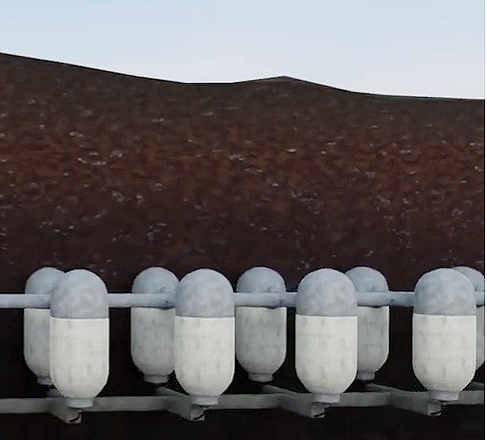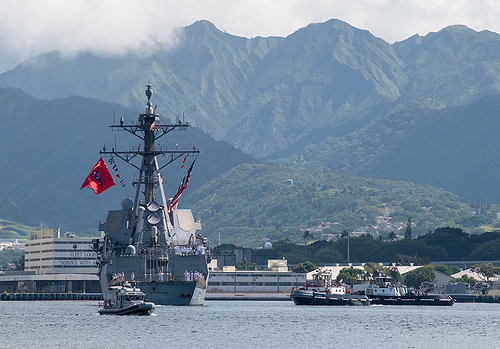
HONOLULU, Hawaii, March 8, 2022 (ENS) – The underground Red Hill Bulk Fuel Storage Facility in the hills above the Pearl Harbor Naval Station on Oahu will be de-fueled and permanently closed, Secretary of Defense Lloyd Austin announced Monday. The facility holds more than 100 million gallons of fuel in support of U.S. military operations in the Pacific, but just 100 feet directly below the facility floats the Southern Oʻahu Basal Aquifer, the primary drinking water source for the island.
This action follows a November 2021 fuel leak and resulting contamination of Oahu’s drinking water that forced nearly 4,000 military personnel and civilians serviced by the Navy’s water system from their homes. More than 6,000 people with symptoms linked to fuel exposure were seen at military health facilities.
Now, the Navy’s Red Hill Shaft, which is contaminated, has been disconnected from the water system.
The problem was first reported November 28, 2021 when the Hawaii Department of Health was notified that Navy water system users on Oahu reported fuel-like odors in their tap water. The Navy’s water system serves some 100,000 people in and around Joint Base Pearl Harbor-Hickam.
The next day, the Hawaii Department of Health, DOH, ordered the Navy to suspend operations and safely remove the fuel from the 20 underground storage tanks at Red Hill.
Initially, the Navy resisted the order to drain the fuel tanks. The Red Hill Facility currently stores and dispenses three types of petroleum fuel – marine diesel for ships and two types of jet fuel, JP-5 and JP-8.

Now, after consultation with senior civilian and military leaders, Defense Secretary Austin has decided to shut down the fueling facility, in coordination with the state Health Department, the U.S. Environmental Protection Agency, and community groups.
“No later than May 31, the Secretary of the Navy and Director of the Defense Logistics Agency will provide an action plan for safe and expeditious defueling of the facility, with a completion date target of 12 months,” Secretary Austin said.
“Then, as soon as we have made corrective actions to ensure that defueling will be safe, we will begin defueling. Then we will move to permanently close the Red Hill facility, including conducting any and all necessary environmental remediation around the facility,” the secretary said. The fuel removed from the tanks will be relocated to other storage facilities both on land and afloat.
“This is the right thing to do.”
“We’re pleased with the Secretary of Defense’s decision to do the right thing for the people and environment of Hawaiʻi,” said Director of Health Dr. Elizabeth Char, FACEP. “This decision comes late for the Navy water system users who have borne the greatest burden of this humanitarian disaster, but it’s nevertheless reassuring that the imminent threat posed by this troubled facility will finally be addressed. We are anxiously awaiting receipt of the DOD’s written plan and a path forward to ensure independence of the Navy’s contractor.”
Secretary Austin promised to continue to work with the Hawaii Department of Health, national and local elected officials, and other community leaders to clean up the water at the Red Hill well. And he said the Defense Department will “develop an environmental mitigation plan to address any future contamination concerns.”
“When we begin to consider land-use options for the property after the fueling facility is closed, we will stay in lockstep with communities in Hawai’i. Nothing will be decided without careful and thorough consultation with our partners,” Austin pledged.
“The same goes for our workforce and their families. Your health has been impacted, your lives and livelihoods have been disrupted, and in many cases, your very homes have been rendered unavailable to you. We owe you the very best health care we can provide, answers to your many questions, and clean, safe drinking water. Quite frankly, we owe you a return to normal. And you have my commitment to that end,” he said.
“We’re encouraged by the Secretary of Defense’s promise of an action plan for safe and expeditious defueling of the Red Hill facility,” said Hawai’i state Deputy Director of Environmental Health Kathleen Ho. “On behalf of the people and environment of Hawaiʻi, we will remain vigilant to hold the Navy accountable to render the drinking water supply safe and to address future contamination concerns.”
The state health department‘s “do not drink” order for all customers on the Navy’s water system, including 100,000 residents, and dozens of schools and businesses, remains in effect for most customers.
Finding the Funding
President Joe Biden signed a short-term federal funding bill on February 18 that includes a provision, introduced by U.S. Senator Brian Schatz of Hawai’i, a Democrat, to push the Department of Defense to abide by the Department of Health’s emergency order to drain the Red Hill fuel tanks.
The measure provides $100 million for the Navy to follow the defueling order and represents the first round of funding to drain the tanks, a process that requires sizable appropriations. The bill also includes $250 million for the Navy, Marine Corps, Army, and Air Force to cover the expenses of the water contamination.
A member of the Senate Appropriations Committee, Senator Schatz said, “There will be challenges ahead, but make no mistake: Red Hill will be shut down. In order to implement this decision, we’re going to have to provide additional resources and hold DoD’s feet to the fire through congressional oversight. I will continue to work with our federal and state partners to see this through.”
It Was a Good Idea, Once Upon a Different Time
In his announcement, Secretary Austin reminded everyone that the Red Hill Bulk Fuel Storage Facility was built during WWII and that entirely different circumstances today require different fueling facilities.
“Centrally-located bulk fuel storage of this magnitude likely made sense in 1943, when Red Hill was built,” Austin said. “And Red Hill has served our armed forces well for many decades. But it makes a lot less sense now. The distributed and dynamic nature of our force posture in the Indo-Pacific, the sophisticated threats we face, and the technology available to us demand an equally advanced and resilient fueling capability.”
“To a large degree, we already avail ourselves of dispersed fueling at sea and ashore, permanent and rotational. We will now expand and accelerate that strategic distribution,” Austin disclosed.
To advance the goals set forth in the U.S. Indo-Pacific Command’s long-term plan for strategic fuel storage in the Pacific, the Department of Defense, DoD, says it will “reposition fuel stored at Red Hill by leveraging commercial infrastructure.”

The DoD pledged to ensure that “relocated fuel will be stored according to all applicable environmental regulations. Afloat storage vessels will be U.S. flagged and crewed and will be operated in accordance with U.S. Coast Guard safety and environmental standards.”
Secretary Austin said the Department of Defense plans to realign fuel reserves for operations in the Pacific theater to support its vessels “while protecting the people of Hawai’i, military families, the environment, and the security of the nation.”
The Sierra Club and other groups have sued the Navy over the spills at Red Hill.
Their attorney, David Henkin of Earthjustice, said, “The Department of Defense has finally acknowledged that the Red Hill facility needs to be shut down to avoid further contamination of O‘ahu’s water supply,” said . “Now, the Navy needs to drop its appeals of the Department of Health’s emergency order requiring defueling of the Red Hill tanks, and withdraw its application for a permit to keep operating the polluting facility.”
“There’s still a lot of work that needs to be done to identify the current plume in the aquifer – where it is, where it may be going and how we can stop it from migrating over to the municipal wells,” said Wayne Tanaka, director for the Sierra Club of Hawaii. The group estimates that at least 19,000 gallons of fuel remain in the underground water supply.
Over its almost 80 years of operation, the Red Hill facility has reported nearly 80 leaks into the environment. Because of the nature of the volcanic substrate below the facility, the 200,000 gallons that have leaked from this facility have never been cleaned up.
“For years, the Navy has been telling us that the Red Hill facility is vital for national security and irreplaceable. Now, the Secretary of Defense has done a 180 and concluded that the facility is out-of-date and that, in the 21st century, there are much better ways to supply the military with fuel. This just goes to show that we really need to take a healthy dollop of salt with the military’s claims that its decades-old, environmentally destructive ways of doing things are necessary to defend the nation,” scolded Henkin.

“The Sierra Club of Hawaiʻi is supremely grateful for the countless voices that have brought us to this point in the fight to save our water,” said Tanaka. “This includes the Board of Water Supply, the Department of Health Environmental Health Administration, the elected representatives supporting the shutdown of Red Hill, and, most importantly, the many grassroots organizations like the Oʻahu Water Protectors, the Kaʻohewai Coalition, and the many, many other groups and individuals who stepped up and answered the call to defend our island’s source of life from this decrepit fuel facility.”
U.S. Senator Mazie Hirono, a Democrat representing Hawai’i and a member of the Senate Armed Services Committee, agrees that there is a lot of work to do to defuel the tanks safely and accomplish the clean up required to close down the facility. “I have said from day one that ensuring the health and safety of the residents of Oahu is my top priority, and I share the community’s big sigh of relief with this news.”
With U.S. strategic military needs in mind, Senator Hirono said, “I will work closely with DoD to ensure the Department has the resources to develop and implement a long-term plan to ensure we are able to meet the strategic fuel reserve needs of the Indo-Pacific Region and protect national security as the nation shifts to a more distributed force posture in the Pacific.”
Featured image: U.S. Secretary of Defense Lloyd Austin addresses troops at Joint Base Pearl Harbor-Hickam, March 15, 2021 (Photo courtesy U.S. Indo-Pacific Command)



